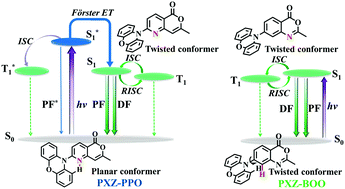Abstract:
Thermally activated delayed fluorescence (TADF) emitters generally require good separation of highest occupied molecular orbital (HOMO)–lowest unoccupied molecular orbital (LUMO) overlaps to minimize the singlet–triplet energy offset. Observations of excellent TADF performance in several planar emitters with large HOMO–LUMO overlaps are counter-intuitive and not fully explained. To understand this, we prepared two isomeric TADF molecules, 7-methyl-2-(10H-phenoxazin-10-yl)-5H-pyrano[4,3-b]pyridin-5-one (PXZ-PPO) and 2-methyl-7-(10H-phenoxazin-10-yl)-4H-benzo[d][1,3]oxazin-4-one (PXZ-BOO). PXZ-BOO has a stable highly-twisted configuration with a small HOMO–LUMO overlap leading to good TADF performance as expected. PXZ-PPO has a stable nearly-planar form and a large HOMO–LUMO overlap and is not expected to give TADF. While the solid crystal of PXZ-PPO only shows conventional fluorescence at 420 nm, its diluted solution is dominated by TADF at 610 nm. With a combined experimental and theoretical approach, PXZ-PPO is shown to have a stable nearly-planar form and a metastable highly-twisted form in the ground state. While the highly-twisted form only has a small population (<1%) in the ground state, its excited state has lower energy than the nearly-planar form. As a result, when the high population nearly-planar form is excited, its excited state energy can decay by transforming to the highly-twisted form which shows TADF characteristics. This work points out the importance of low population but energetically stable excited states and explains for the first time the origin of TADF in such nearly-planar emitters with large HOMO–LUMO overlaps.
链接:https://pubs.rsc.org/en/content/articlelanding/2020/TC/D0TC03747H#!divAbstract






